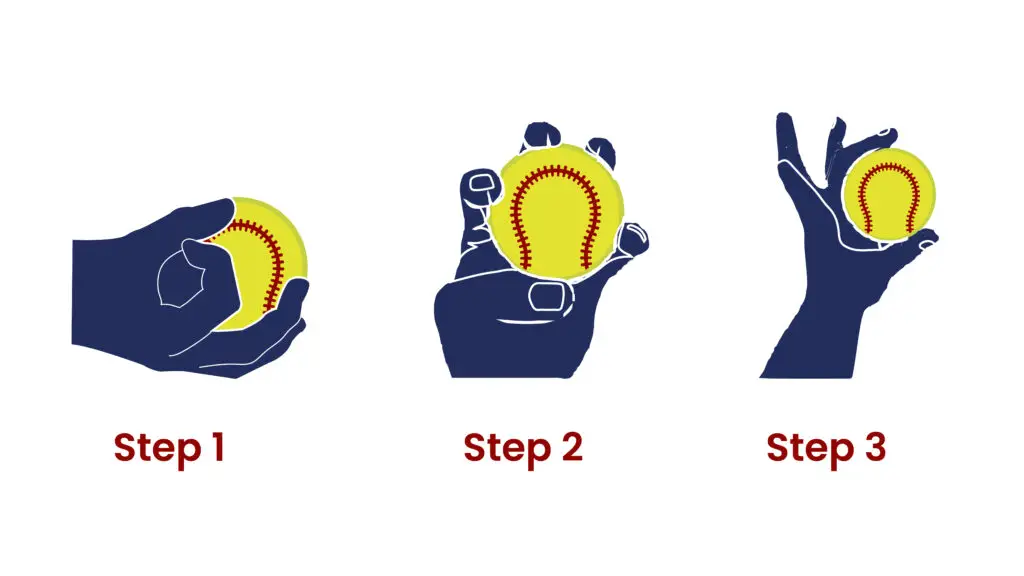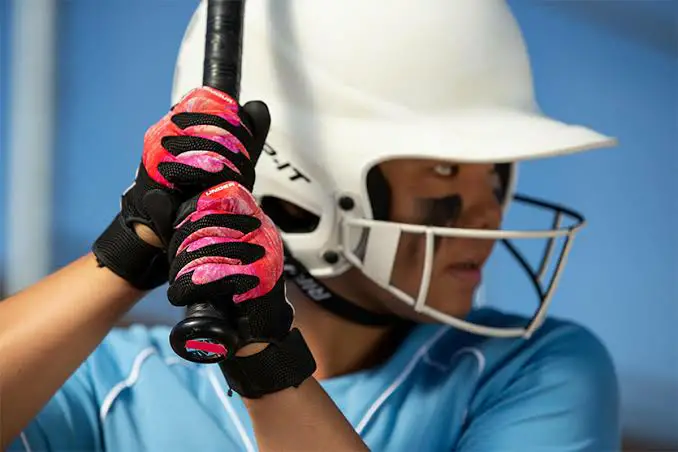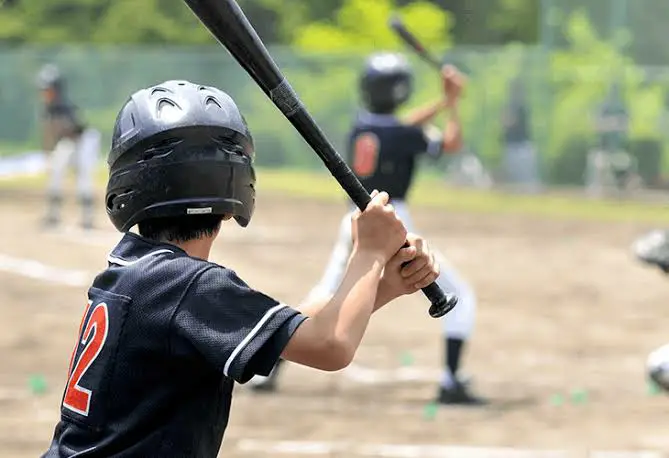For a good swing in softball, it all begins with a firm grip. The key to a secure but relaxed grip is a good hand position. Common practice calls for placing one’s dominant hand over the other, with the two sets of middle knuckles touching. To change this grip, rotate both hands inward or overlap your palms by a small amount. Remember to use your fingers, not your palms, to hold the bat, no matter which grip you use.
We’ll cover the fundamentals and advanced techniques of softball gripping here. You’ll also pick up some tips on improving your spin on the ball, which will help you throw harder and further.

How To Grip a Softball Bat
There are specific methods for softball grips, just as for other sports. The conventional grip causes your wrist to rotate distinctively when swinging a softball bat.
It’s important to have your middle knuckles aligned up whether you’re using a standard grip or a finger grip, and the bat should be within easy reach of your fingers rather than your palm.
Follow the steps outlined below on how to grip the ball:

Locate the handle of the bat and strike a relaxed stance. If you’re right-handed, rest your dominant hand (above your non-dominant hand) on the bat’s handle.
Line up the base of your fingers with the handle of the bat. Do this by placing your right hand on top of your left hand. Holding the bat out in front of you can help you make sure you’re heading in the right direction.
Hold the bat firmly, but not too tightly, by its handle. Next, you’ll straighten your knuckles line so they’re parallel to the floor while your fingers are wrapped around each other. Your knuckles on both hands can be aligned by rotating your hands.
You can test how tightly you hold the bat by swinging it back and forth between your shoulders. Hold still at the knuckles. Keep your grip light and relaxed for a speedier, more powerful swing and less wrist strain.
How to hold a softball bat’s handle

Choose a bat grip that will keep your fingertips secure and comfy. For right-handed batters, it’s crucial to remember that their left hand supports the bat and their right-hand aids with control.
Achieve the ‘power position’ by bringing your hands together in front of your chest.
You can swing by bringing your back knee in and spinning your hips. Keep your hips parallel to the floor, your chin up, and your eyes closed while you rotate. Hold the bat at a 45-degree angle to achieve more powerful, focused strikes.
If you want to hit the ball farther, let your leading shoulder move in the same direction as the ball. Remember that power and efficiency are both affected by the width of the swing arm.
Hit a pitch straight at you in the middle of the plate and right in front of your hip. Getting the most amount of force during a pitch is essential. When the ball is tossed inside, the hips open up quicker to receive it.
The contact point is between the body’s center and the back hip when taking an outside pitch. Therefore, you have to hold your breath until the ball arrives. Thus, the hands progress faster than the bat.
You must be patient and analyze the pitch to hit the ball in different spots.
Keeping the swing going after hitting the ball depends on how fast the ball travels. Keep your weight on the front leg to maintain proper rear shoulder, hip, and knee alignment.
The Finger Grip
Whether you’re using a standard grip or a finger grip, your middle knuckles must always remain in line.
The finger grip is similar to the palm grip in that the bat is folded around the fingers, but the bat is held more firmly in the finger joints than in the palm.
The knuckles in the middle finger should be lined up vertically. Since the finger hold on a bat is similar to the golf grip, golfers may find it easier to use. The following instructions may help you perfect your finger grasp.
Get the bat and set it in front of you (middle of your palm).
To do this, place the bat over the palm of your left hand and wrap your fingers diagonally around the bat, creating a ‘v’ at the top with your thumb in your pointing finger.
Wrap your fingers around the ‘v’ and rest the heel of your right hand there. Straightening the middle knuckles allows you to fine-tune the bat’s length.
Lining up your Knuckles when Batting
If you want your knuckles to stay in a nice, even line, employ the thumb grip. Because of how tricky it is to spot, this strategy is rarely widely used.
Players have a common mental image of lining up their knuckles in preparation to knock on someone’s door. It helps you maintain an upright position after finishing your swing and prevents you from sliding too quickly.
Someone is instructed to line up their knuckles before swinging a bat and then discovers that their knuckles are no longer lined up.
The key to knuckle alignment is to rest your thumb on the handle instead of your palm to prevent your fingers from falling off. To use it, you must place your left thumb under your right thumb.
A subset of people does the thumb trick by shifting their thumb to the side. Most collegiate softball players do not wrap the bat around their hands. They switch thumb positions regularly to maintain a straight grip and aligned knuckles on their fingers.
You can apply their techniques to improve your proper wrist snap by maintaining the same body posture they recommend.
If your knuckles aren’t in the right place and you try to drive ahead, your wrist will stay straight instead of bending the other way, causing you to lose a lot of power.
How to Grip and Snap a Fastball in Softball
Softball beginners start by learning the fastball because it is one of the most fundamental pitches. However, simplicity does not automatically equate to inefficiency. A powerful fastball is an excellent tool for inducing swings and misses from batters.
Maintaining the ball’s trajectory command requires a firm grip and a strong proper wrist snap, just as with any other pitch.
Fastball Grip
The grip refers to the posture of the fingers when holding the ball. You should look for a “C” within the stitching if you’re going for the fastball grip. The direction of this “C” is arbitrary.
You can keep three or four fingers touching a seam at all times. With your fingers in this position, you’ll be able to snap the ball off with more force and generate more spin. The greater the number of revolutions you can induce in the ball, the faster it will go.
Fastball Snap
Now that you know how to hold the ball, you must also learn to let go of it. Fastballs are thrown from the back of the hand. During the follow-through of your fastball motion, pretend you are trying to jab yourself in the shoulder.
You may use this to achieve a perfect “12-6” spin on the ball. You can think of the 12 and 6 as the hands of a clock. The ball completes a 12-6 revolution when it goes from the position that would be the 12 at the top of a clock directly down to the 6 at the bottom.
What can I do to better my softball throw?
If you want to become a better softball pitcher, try these tips.
Do throwing drills and concentrate on your footwork to improve your mechanics.
Improve your physical fitness! If you want to throw quicker, get bigger and start a strength and conditioning program with a skilled coach.
Carry out a regimen of arm strengthening exercises—these aid speed by immediately building strength in the shoulder and rotator cuff.
Strengthen your body and mind by training more. Increase your overall fitness by running more sprints and a few long distances.
Throw four or five times a week. If you only throw twice or three times a week, you won’t give your arm enough chance to expand.
Improve your mechanics and maximum throwing velocity by setting and achieving longer-distance throwing goals.
Can softball players benefit from practicing with baseballs?
Yes, softball players can benefit from practicing with smaller balls like the one in baseball.
As part of their training, softball players should toss baseballs (or other smaller, lighter balls).
These lighter, smaller baseballs are ideal for developing faster arm speeds and strengthening the rotator cuff and other throwing muscles.
Also, young players typically have smaller hands, so baseball makes it easier to teach them proper mechanics and throw with accuracy.
